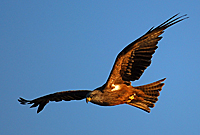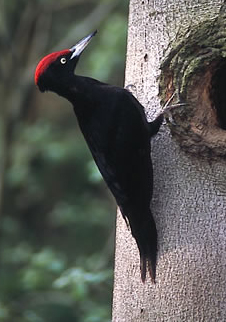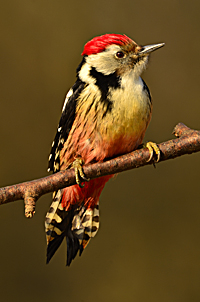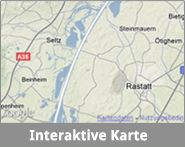Birds
Species of the Birds Directive
A pair of binoculars and open ears, these are the prerequisites for the observation of birds. Most of the species you will hear in spring and early summer during the morning hours, but also in autumn and winter you can spot migrating birds and winter guests in the area, which has19 species listed in the Birds Directive.
What they look like, where and how they live – here can you read more about them.
- " typeof= The dense riverside vegetation rarely discloses the Little Grebe, but you can frequently hear their voice which is kind of trilling (“bebebebebe”). Their courtship is a must-see for anybody: a non-stop swimming towards each other, plunging, shaking their heads, and sometimes even artistically twisting their legs. You find the little grebe around oxbow lakes and lakes in the floodplain, e.g. in the Bremengrund, at the Illinger Altrhein and the Bärensee, in the Wintersdorfer Altrhein and in Rhine floodplain of Rastatt. Read more
- " typeof=
The last observation of the critically endangered Little Bittern was made five years ago at the Saumseen close to Karlsruhe. This smallest heron-species lives in accretion zones with a dense interlocking of reed zones and water surfaces. The little bittern is particularly sensitive towards disturbances during breeding, and this might be the reason that it cannot be met regularly anymore. Read more
- " typeof=
- Each child knows the White Storch from childrens’ books and songs, but only if you have observed a pair of storks clattering their welcome in the aerie you will get a real impression of this popular bird. And then children should also know that the White Stork hardly eats frogs but mostly insects, mice and earthworms. In the area and its surroundings there are not only artificial breeding sites (e.g. near Forchheim on a pylon and in Neuburgweihe on the school building) but also natural aeries (e.g. on the broken stem of a poplar at the Illinger Altrhein and in the Bremengrund). Read more
- " typeof= In spring and summer the Common Teal will be hardly met at the Rhine river. The smallest native duck got its German name "Krickente" from its typical cries (“crik” or “cryk”), and it usually migrates up north into the Scandinavian and Russian Tundra. In winter and during migration, which is from August to March, it can be observed more frequently in shallow water zones and in silty and muddy areas. These zones, which can also fall dry, are particularly important for the species during migration and hibernation. Read more
 " typeof=
The slightly forked tail is the distinctive feature of the Black Kite compared to the similarly sized buzzards. It can also be recognized from its slow, mostly low flights over water surfaces, river shores and the open countryside. It feeds on nearly everything: fish, birds, mice, critters, amphibians, insects, earthworms, but also waste and carrion. Often the black kite breeds in mixed colonies with cormorants and grey herons, stealing them even a prey animal from time to time. Read more
" typeof=
The slightly forked tail is the distinctive feature of the Black Kite compared to the similarly sized buzzards. It can also be recognized from its slow, mostly low flights over water surfaces, river shores and the open countryside. It feeds on nearly everything: fish, birds, mice, critters, amphibians, insects, earthworms, but also waste and carrion. Often the black kite breeds in mixed colonies with cormorants and grey herons, stealing them even a prey animal from time to time. Read more- " typeof= In winter the European Honey Buzzard lives in the tropics and in South Africa. For the summer it migrates to Central Europe. As its German name Wespenbussard suggests it mainly feeds upon larvae, pupae and also wasps, bumblebees and bees by digging out their nest. Currently no breedings sites are known in the area, but it frequently forages on meadows and floods dams. Read more
- " typeof= Sometimes the Western Marsh-harrier seems to fly quite unstable and wavering, but it is skilful flier able to catch small animals up up rat-size. In spring (March/April) you can observe the impressive courtship flights of the male harriers high in the sky which are accompanied by cheering cries. The female build their aeries from old rushes and brushwood in dense reed zones, frequently above the water. Whilst the harriers are breeding north of the project area near Rheinstetten and at the Knielinger See, in the area only individual food-seeking harriers have been seen near Wintersdorf. Read more
- " typeof= Instead of building own nests the Eurasian Hobby usually uses old nests of crows and other birds. With its long sickle-shaped wings it is a typical “aerial hunter”, reaching a speed of 100 to 200 km/h. It mainlyfeeds on insects (such as dragonflies) but also on smaller birds. The perfect landscape for the Eurasian Hobby consists of a diverse mixture of open forests, shrubs and trees, meadows, wetlands and water bodies. In the project area it occurs in the Bremengrund, at the Illinger Altrhein and over the entire Rhine floodplain near Rastatt. Read more
- " typeof= Loud calls out of reed beds, reminding of squealing pigs, usually suggest the occurrence of Water Rails. In summer you will hardly ever see one of them, whilst in winter you can observe them easily at ditches and streams. North of the project area breeding sites have been confirmed in the Rhine floodplain, and water rails probably also breed in the reed beds of the Wintersdorfer Altrhein and the Bannwasser. Read more
- " typeof= The Common Sandpiper usually flies very quickly and smoothly over the water surface, uttering shrill screams (“he-de-de”). It also can swim and plunge. On the ground the sandpipers frequently wag their tail up and down. As breeding site they prefer shallow depressions on the ground within dense vegetation, mostly on islands or close to the shore. Sometimes they have been seen at the Auer Köpfle but seem not to breed there yet. The largest obstacle to successful breeding are the permanent disturbances during breeding time (April and May, rarely June) caused by ramblers, anglers and canoeists. During migration in spring and autumn the sandpiper can be observed along the banks of the Rhine river. Read more
- " typeof= The Common Tern shows most impressive crash dives when catching small fish and insect larvae. It was nearly extinct at almost all large rivers in Germany because the straightening of the rivers caused the loss of natural shingle banks which are necessary for its breeding colonies. Owing to the establishment of artificial nesting areas (rafts and deposited islands) the populations have slightly recovered. The common tern uses all larger water bodies in the project for feeding. A few years ago nesting rafts have been provided at the Wörthfeldsee north of Plittersdorf, but also on the other side of the Rhine river, e.g. near Lauterbourg. After finishing the measures at the Kohlkopf and on the Tomateninseln the newly developed shingle banks could represent ideal breeding habitats for the common tern. Read more
- " typeof=
- With its opalescent blue plumage the Common Kingfisher is one of the most beautiful birds in our latitudes. Usually you only see it whizzing over the water in low-level flight. One must be lucky to spot it sitting on a branch over the water surface. In spectacular dives it hunts small fish, pollywogs and insects. The kingfisher breeds in caves in the ground which it digs up to 90 cm into the ground e.g. into washing banks. Its habitats are clear waters in the Rhine valley – it has to see the fish from above – such as the river Murg in Rastatt or the Gänsrhein north of Plittersdorf. Read more
- " typeof=
- The Wryneck is a master of camouflage since it can hardly be detected in the trees due to its bark-like coloured brownish feathers. In spring, however, his calls can be easily identified due to their slightly increasing sound like “wed-wed-wed-wed-wed”. The wryneck belongs to the woodpeckers but doesn’t peck holes. In the area he occurs for example in the abandoned orchards at the Illinger Altrhein und between Gänsrhein and Wörthfeldsee. It feeds almost exclusively on ants and digs for their eggs and pupals in the open landscape on species-rich meadows, at flood dykes and also in former gravel pits. Read more
- " typeof= If you find insects or mice impaled on thorns or barbed wires you have probably discovered the larder of a Red-backed Shrike. With its hooked beak it collects its prey and eats it when the weather is unfavourable. Red-backed shrikes have been observed close to the Plittersdorfer Fähre and at the sports ground of Wintersdorf. Their habitats comprise all species-rich meadows and hedges in the surrounding, up to Ottersdorf and north of Plittersdorf. Read more
- " typeof=
- A blue throat with a white throat spot is the distinguishing mark of the Bluethroat. It has a melodic song and imitates other birds or even mechanical sounds. It sings until late at night and also early in the morning before dusk. The bluethroat needs reeds and willow hedges combined with sites without vegetation. The lack of these open sites might be the reason why the bluethroat hasn’t been observed in the area over the last years. Read more
- " typeof=
- The Stock Pigeon is one of our wild pigeons that is seen quite rarely. It lives in forests and often uses the holes of black woodpeckers in old trees as nests. You can identify it from its call, a deep “Oo-uo, oo-uo, oo-uo“ in the forests around Neuburgweier, in the communal forest of Au am Rhein and at the Illinger Altrhein, in the forest stands north of Plittersdorf as well as northwest of Wintersdorf. Watch out for pigeons foraging on fields and meadows: the stock pigeon can be identified from its very dark eyes, the iridescent greenish-purple neck and the two dark bands on its wings. Read more
 " typeof=
You can hear the enduring drumming of the Black Woodpecker mainly in the woodlands around Neuburgweier, in the communal forest of Au am Rhein and at the Illinger Altrhein, in the forest stands north of Plittersdorf as well as northwest of Wintersdorf (e.g. in the area “Alte Sandbachmündung” and in the area “Hüttenköpfel”). Its remarkable calls sound like “cru…cru” or “klieuh” and can be heard from far. With a little practice you might detect it sitting on the trunk of a big tree. The black woodpecker plays a key role in the forest due to its hole pecking, since many other species use these holes in subsequent years. Read more
" typeof=
You can hear the enduring drumming of the Black Woodpecker mainly in the woodlands around Neuburgweier, in the communal forest of Au am Rhein and at the Illinger Altrhein, in the forest stands north of Plittersdorf as well as northwest of Wintersdorf (e.g. in the area “Alte Sandbachmündung” and in the area “Hüttenköpfel”). Its remarkable calls sound like “cru…cru” or “klieuh” and can be heard from far. With a little practice you might detect it sitting on the trunk of a big tree. The black woodpecker plays a key role in the forest due to its hole pecking, since many other species use these holes in subsequent years. Read more
 " typeof=
A loud squawking is the typical sound of the Middle Spotted Woodpecker, whilst its drumming can be heard only very rarely. The courtship call consists of up to 30 individual sounds and can be heard in rather light forest stand with oaks between middle of March and April, e.g. in the alluvial hardwood forests in the south close to Wintersdorf (areas “Hüttenköpfel” and “Bannwald”), in the Füllergrund, in old remnants of poplar and willow west of Plittersdorf, and north of the river Murgh in the “Silberweidenwald Steinmauern” with its extensive and partially very old stands of willow trees. Read more
" typeof=
A loud squawking is the typical sound of the Middle Spotted Woodpecker, whilst its drumming can be heard only very rarely. The courtship call consists of up to 30 individual sounds and can be heard in rather light forest stand with oaks between middle of March and April, e.g. in the alluvial hardwood forests in the south close to Wintersdorf (areas “Hüttenköpfel” and “Bannwald”), in the Füllergrund, in old remnants of poplar and willow west of Plittersdorf, and north of the river Murgh in the “Silberweidenwald Steinmauern” with its extensive and partially very old stands of willow trees. Read more
- " typeof= The Grey-headed Woodpecker is sometimes also called “ground woodpecker” since it forages on the ground, just like the green woodpecker. Its far-reaching song in the forest sounds quite sad and unsettled. The strophe consists of 10 to 15 individual notes, sounding melancholic and soulful, and it dies away towards the end. You can hear the grey woodpecker depending on the winter from middle or end of February to beginning of April in the communal forest of Au am Rhein and in the complete floodplain of the Rhine river (e. g. in the alluvial hardwood forests in the south close to Wintersdorf in the areas “Hüttenköpfel” and “Bannwald”, in the woodlands along the flood dykes in the eastern part of the area). Both male and female are drummers, and their drum rolls can reach up to 40 beats, lasting about two seconds. Read more



